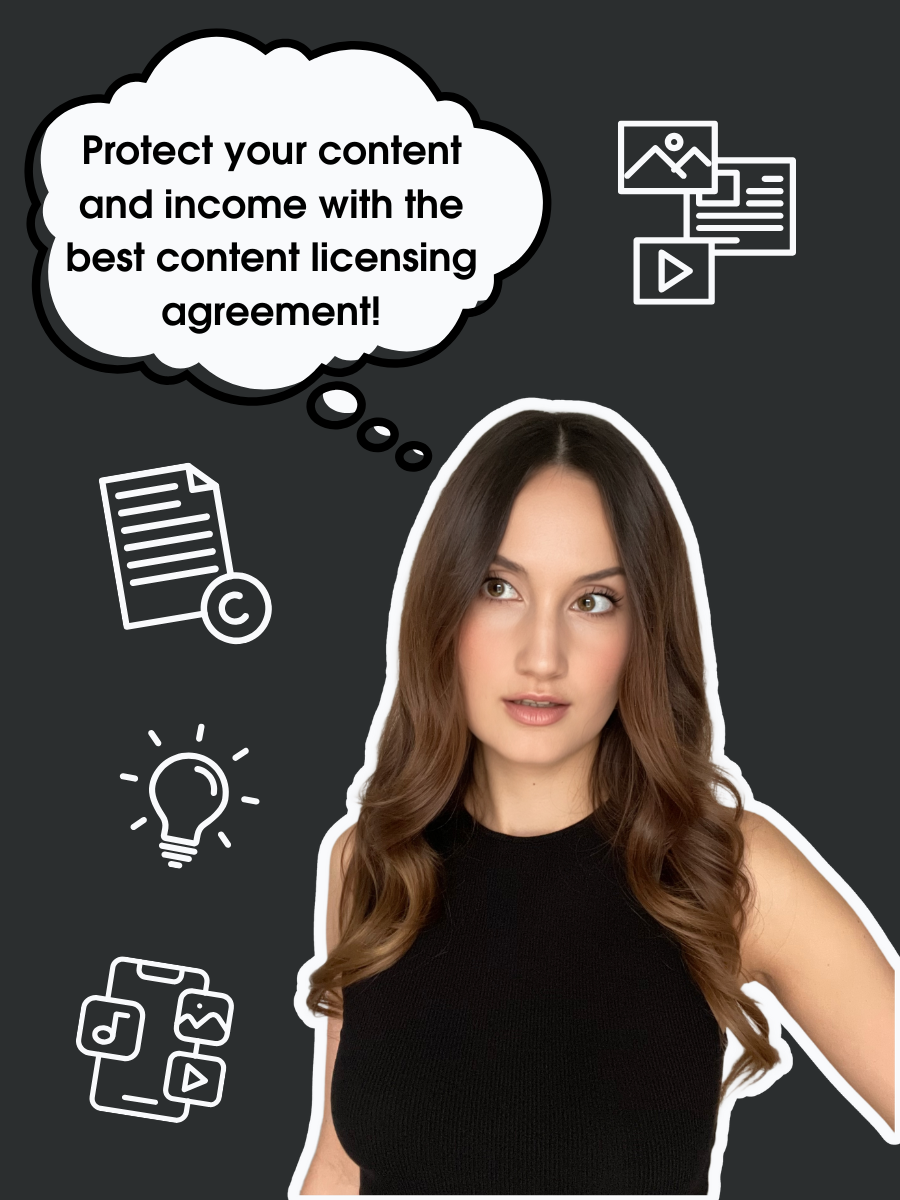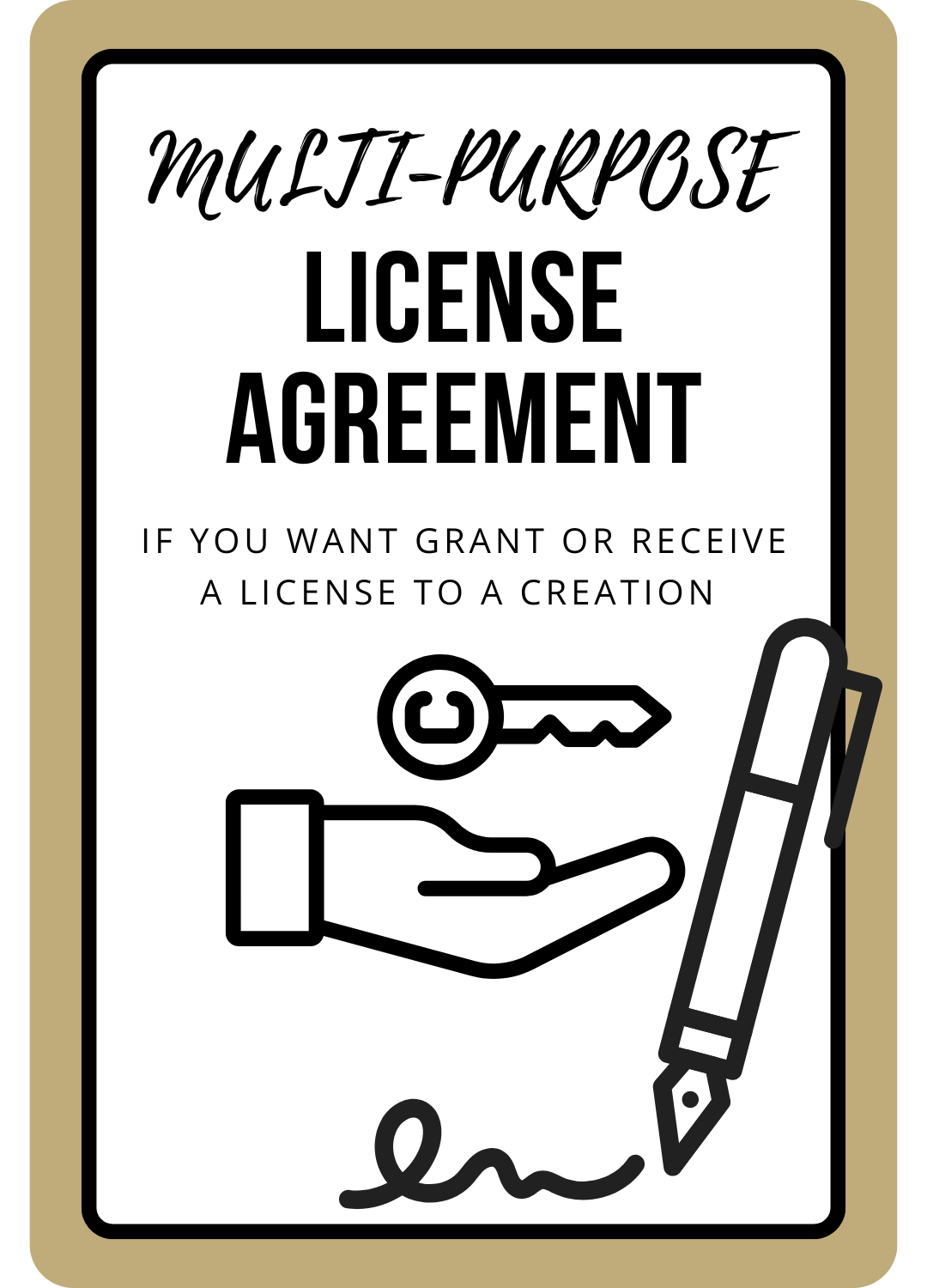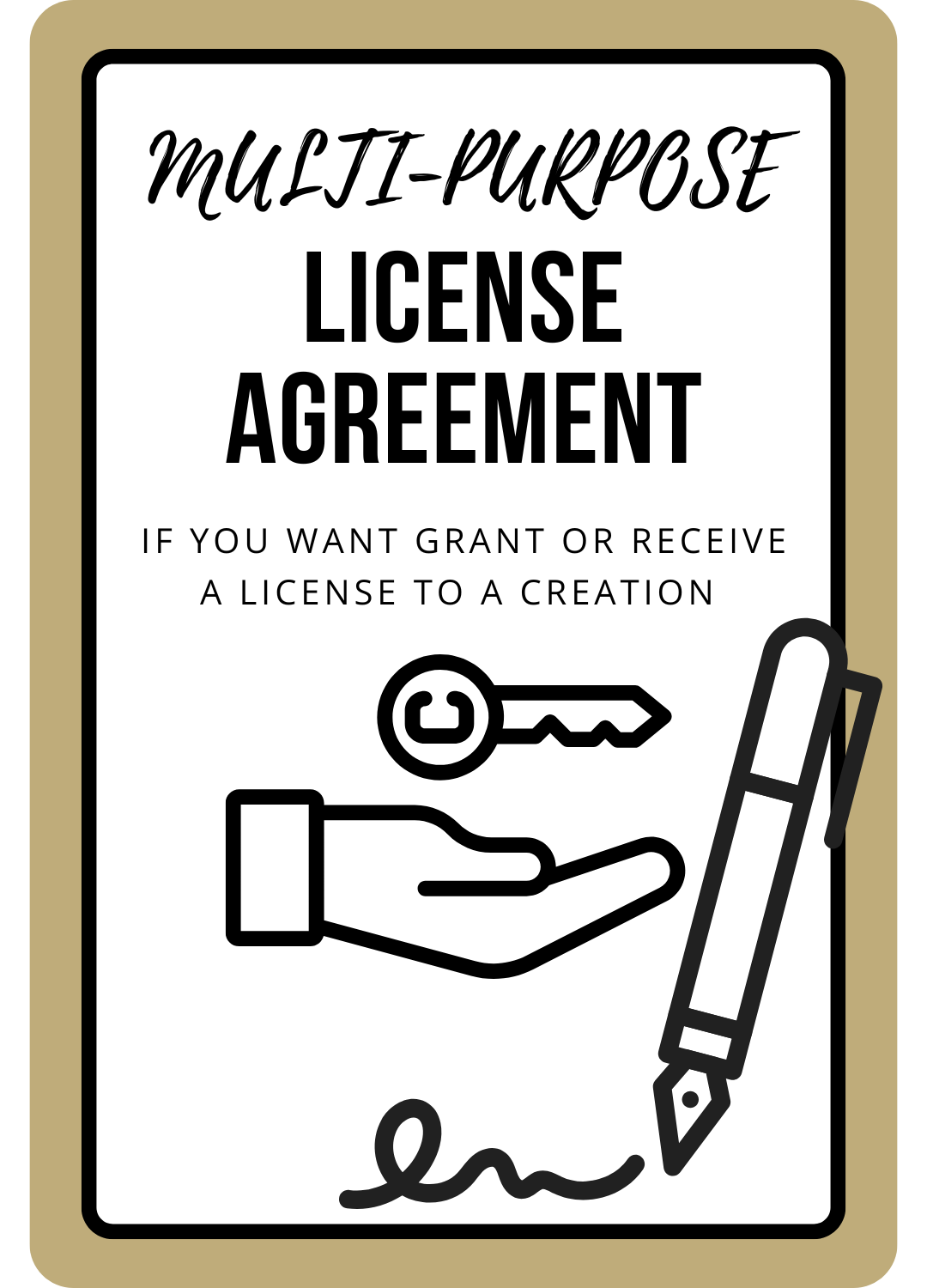10 Must-Haves for Your Content Licensing Agreement (to Protect Against Misuse & Non-Payment)
Why is an ironclad content licensing agreement non-negotiable if you let others use your work? If you don’t have the right protections in place, you could lose control of your content, miss out on payment, or see your work repurposed in ways you never agreed to.
I’ve seen too many creators and business owners hand over their hard-earned content with nothing more than a handshake, a vague email thread, or a random contract pulled from the internet. That’s risky. A proper content licensing agreement not only protects your rights, it also sets clear boundaries for how, where, and why your content can be used—plus what happens if you don’t get paid.
In this post, you’ll learn the 10 must-have clauses every content licensing agreement needs. We’ll walk through content licensing examples, types of licensing agreements, and content licensing fees—all in plain English.
By the end, you’ll know how to safeguard your content and make sure you’re paid fairly.
This post is all about the 10 must-haves for your content licensing agreement to protect against misuse and non-payment.
👉 Ready to protect your content? Get my Content Licensing Agreement Template — lawyer-drafted, with both licensor-friendly and licensee-friendly versions included, and easy to customize.
Best Content Licensing Agreement
The 10 Must-Haves for Your Content Licensing Agreement Template: From Content Licensing Examples to Content Licensing Fees
1. Define the Licensed Content Clearly
One of the biggest mistakes I see in licensing agreements? The content isn’t clearly defined. Too many contracts simply state “the work” or “the content” without clearly specifying what that means. That vagueness opens the door for disputes: did you license one photo, the whole photoshoot, or even the raw files?
That’s why your content licensing agreement must spell out exactly what’s being licensed—and ideally, include a copy of it as an annex to the contract. This leaves no room for interpretation and protects you if the licensee attempts to claim they have rights to more than you agreed upon.
Example: You grant a brand the right to use one photo from your gallery. Without a clear clause, they publish the entire photoshoot across their socials. With a proper agreement that attaches the licensed photo as an annex to your contract, you can immediately prove they overstepped.
Pre-written in my Content Licensing Agreement Template — just attach the work you’re licensing, and you’re covered.
2. Choose the Right Type of License
One of the most important decisions you’ll make in your content licensing agreement is whether you’re granting a sole license or a non-exclusive license.
Here’s the difference in plain English:
Sole license → only you and the licensee can use the content. You can’t license it to anyone else.
Non-exclusive license → you can license the same content to multiple people at the same time, keeping your earning potential open.
Choosing the wrong type can have serious consequences. If you meant to give a non-exclusive license but accidentally worded it as “sole” or even “exclusive,” you could lock yourself out of future opportunities to license that content to others.
Example: You license a photo to one magazine under an exclusive license. A month later, another magazine offers to pay for that same photo—but you can’t accept, because your contract gave the first magazine exclusive rights (even though you didn’t intend to).
That’s why my licensor-friendly version of the template does not include the option for an exclusive license. Exclusive licenses heavily favor the licensee and limit your freedom to monetize your content elsewhere.
If you ever do want to give exclusive rights, that option is available in my licensee-friendly version of the template instead. So, you get two types of licensing agreements for different purposes.
👉 My Content Licensing Agreement Template includes both sole and non-exclusive options, along with clear explanations, enabling you to choose the one that best suits your business needs.
3. Set the Term of the License
Next, your content licensing agreement should clearly state whether the license is perpetual, for a fixed period, or automatically renewing.
Here’s how the options work in practice:
Perpetual license (indefinite) → the license lasts forever unless terminated. Useful if you want the licensee to always have access, but risky if you later want to monetize the same work elsewhere.
Fixed-term license (with end date) → the license automatically ends on a specific date. Best for campaigns, collaborations, or projects with a clear timeframe.
Auto-renew license → the license renews after each period (e.g., every 12 months) unless either party gives notice. Useful for ongoing collaborations that require built-in continuity.
Without one of these options in writing, a licensee could argue they have rights to use your content indefinitely—even if you only intended it for a short-term project.
Example: You license a song for use in a brand’s 3-month ad campaign. Without a clear end date, they could continue running the ad for years, with no additional payment.
👉 My Content Licensing Agreement Template provides you with all three options, pre-written and explained, so you can select the term that best suits your deal.
4. Specify the Purpose of the License
The purpose clause in your content licensing agreement limits how the licensee can use your work, making sure it’s only used in the way you intended.
Without a clear purpose, they could repurpose your content for projects you never agreed to—and make extra money off it without compensating you.
Here are some common content licensing examples:
Marketing campaign → e.g., “to use the photo for the licensee’s 2025 spring campaign on Instagram and Facebook.”
Educational content → e.g., “to include the video in the online course [name] on [platform] for paying members only.”
Editorial use → e.g., “to publish the article in a digital magazine issue of March 2025.”
Internal use → e.g., “to use the template internally within licensee’s business for training its employees, not for resale.”
Portfolio/display → e.g., “to showcase the content in a client case study on the licensee’s website [domain name].”
Example: You grant a license for a blog post. Without a purpose clause, the licensee could also use it in their paid eBook. With a clear purpose defined, you can stop that misuse.
👉 Already built into my Content Licensing Agreement Template — just fill in the purpose, and you’re covered.
5. Control Where the Work Appears
Another must-have clause in your content licensing agreement is the locations/platforms clause. It sets the boundaries for where your work can be published. Without it, a licensee might use your content far beyond what you intended—like reposting it on every platform they own, or even behind a paywall.
Here are examples of how you might restrict locations:
Social media only → “to publish the video on Instagram under the handle @BrandName.”
YouTube channel → “to post the content on the channel @BrandChannel, accessible to subscribers for free.”
Website → “to publish the work on the licensee’s website at www.example.com.”
Email marketing → “to include the graphic in promotional emails from newsletter@example.com.”
Membership area → “to make the content available only inside the licensee’s paid membership portal.”
Example: You license a video for use on a brand’s Instagram. Without a location clause, they also upload it to YouTube and add it to their paid course. With this clause in place, you can prove they exceeded the license.
✨ Get all these protections (and more) built into one contract.
My Content Licensing Agreement Template makes sure you:
✅ Clearly define exactly what content is licensed
✅ Choose the right license type (without locking yourself out of future deals)
✅ Control how long the license lasts — perpetual, fixed, or auto-renewal
✅ Limit the purpose of the license so your content isn’t misused
✅ Specify where your work can appear (and nowhere else)
All pre-written, lawyer-drafted, and easy to customize.
6. Restrict Unauthorized Use
Even if you’ve listed the platforms where your content can be used, you also need to make it crystal clear where it cannot be used. This is where the “for the avoidance of doubt” language in your agreement comes in.
Without this security in your content licensing agreement, a licensee might assume they can reuse your work across new platforms, stick it behind a paywall, or even run it as part of a paid ad campaign—all without your approval or additional payment.
Here’s what the restrictions should cover:
❌ No use on other free or paid platforms without your permission
❌ No uploading your content to third-party services you didn’t approve
❌ No use in paid advertising campaigns unless you explicitly agree in writing
Example: You license a photo for use on Instagram. Without a restriction clause, the licensee also runs it as an ad on Instagram. With this clause, you can demand they take it down or negotiate additional payment.
👉 This safeguard is already included in my Content Licensing Agreement Template, so you don’t leave money on the table.
7. Control Editing and Modifications
Your content represents your brand. Allowing someone else to edit or alter it without restrictions can damage your reputation, distort your message, or even create legal issues if the edits misrepresent your work.
That’s why your content licensing agreement should state that the licensee can’t edit, modify, or adapt your content without your approval. If you do allow changes, you should also reserve the right to give instructions—and to change your mind later.
Example: You license a video to a brand for their website. Without restrictions, they chop it into TikTok clips with captions that misrepresent your message. With an editing clause, you keep full control over how (and if) changes are made.
👉 My Content Licensing Agreement Template already includes a detailed editing clause, giving you the final say over how your work appears.
8. Protect Your Reputation and Rights
Your content is a reflection of you, so you need to make sure it’s never used in a way that harms your reputation or violates your rights. A strong content licensing agreement should explicitly state what the licensee cannot do with your work.
Here’s what your licensing agreement should cover:
❌ No illegal or rights-infringing use
❌ No offensive, defamatory, or discriminatory content
❌ No use that discredits you or misrepresents your brand
❌ No false endorsements or implied sponsorships
❌ No disparaging remarks about you or your work
Example: You license a graphic for use in a brand’s newsletter. Without restrictions, they repurpose it in a political ad campaign, implying your endorsement. With this clause, you can demand they remove it immediately.
👉 Already written into my Content Licensing Agreement Template — so your work stays aligned with your values and reputation.
9. Ensure You Get Paid (Consideration Clause)
Every valid contract needs consideration — something of value exchanged between the parties. In content licensing, that means you must be crystal clear about how you’ll be compensated.
Without a strong consideration clause, you risk giving away your work for free.
Here are the main options, all built into my content licensing agreement template:
Credit only → the licensee gives you attribution whenever they use your work (best for visibility, but no direct income).
Exchange of works → you license your content in return for rights to use something they’ve created (useful for collaborations).
Lump-sum payment → the licensee pays you once, upfront, for the license (great for one-off deals).
Royalties → the licensee pays you recurring fees (monthly, quarterly, or yearly) for ongoing use (ideal for long-term monetization).
Example: You license your podcast intro music. Instead of a one-time payment, you negotiate royalties based on the brand’s ad revenue. This way, your income grows as their use of your work grows.
👉 My Content Licensing Agreement includes all four options, pre-written and explained, so you can pick the structure that best protects your interests.
10. Termination Rights You Can Enforce
Even the best collaborations can go wrong. That’s why your content licensing agreement needs clear termination rights—so you’re never stuck if the licensee doesn’t pay, breaches the agreement, or you simply want to end the deal.
Here are some content licensing examples, so you know what strong termination clauses allow you to do:
✅ End the agreement if the licensee fails to pay on time
✅ Revoke the license immediately if they misuse your content
✅ Terminate for convenience with proper notice (if you’ve built that option in)
Example: You license a photo for a campaign, but the brand misses their payment deadline. With a strong termination clause, you can revoke their rights until they pay in full.
Already built into my Content Licensing Agreement Template — so you always have an exit strategy.
The Ultimate Licensing Bundle with 2 Types of Licensing Agreement
Licensing your content can be an incredible way to monetize your creativity—but only if you stay in control. Without the right clauses, you risk losing ownership, watching your work get misused, or missing out on payment you’re owed.
With a proper content licensing agreement, you set the rules. You decide what content is licensed, for how long, where it can appear, how it can be used, what you’ll get paid, and what happens if things go wrong.
Don’t leave your hard work unprotected. With my Content Licensing Agreement Template, all 10 must-have clauses are already drafted for you—so you can license your work confidently and get paid fairly.
✨ Protect Your Content, Income, and Reputation
Here’s what you’ll get inside my lawyer-drafted template:
✅ Clearly defined licensed content with a copy attached to the agreement
✅ Flexible license types and terms that keep you in control
✅ Specific purposes and platforms to stop misuse
✅ Built-in restrictions against unauthorized use, edits, or reputational harm
✅ Multiple payment structures + termination rights to ensure you’re always paid
👉 Get the Content Licensing Agreement Template here — including both the licensor-friendly and licensee-friendly versions, and easy to customize.
This post was all about the essentials you need in your content licensing agreement to protect your content, income, and reputation.
Other posts you may like:








